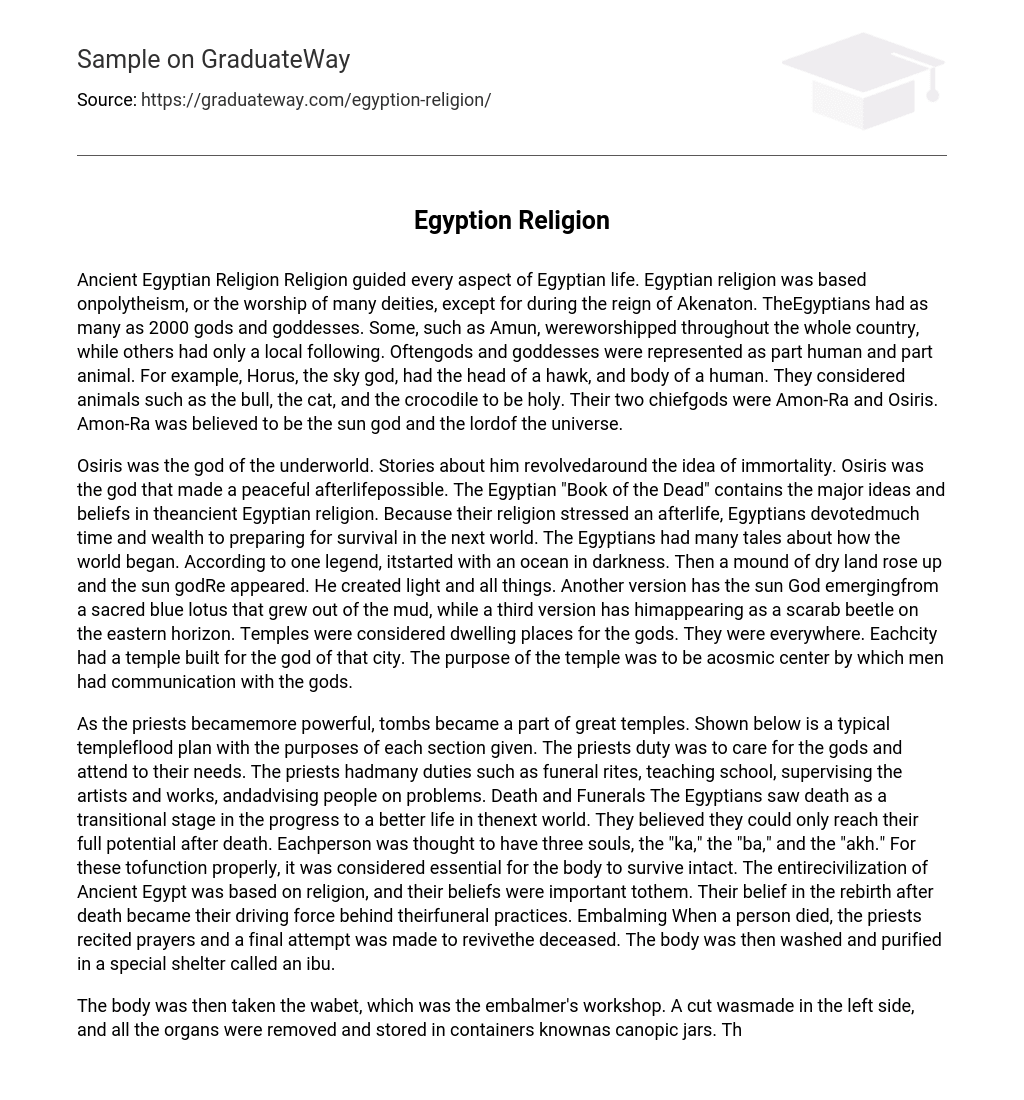Ancient Egyptian Religion Religion guided every aspect of Egyptian life. Egyptian religion was based onpolytheism, or the worship of many deities, except for during the reign of Akenaton. TheEgyptians had as many as 2000 gods and goddesses. Some, such as Amun, wereworshipped throughout the whole country, while others had only a local following. Oftengods and goddesses were represented as part human and part animal. For example, Horus, the sky god, had the head of a hawk, and body of a human. They considered animals such as the bull, the cat, and the crocodile to be holy. Their two chiefgods were Amon-Ra and Osiris. Amon-Ra was believed to be the sun god and the lordof the universe.
Osiris was the god of the underworld. Stories about him revolvedaround the idea of immortality. Osiris was the god that made a peaceful afterlifepossible. The Egyptian “Book of the Dead” contains the major ideas and beliefs in theancient Egyptian religion. Because their religion stressed an afterlife, Egyptians devotedmuch time and wealth to preparing for survival in the next world. The Egyptians had many tales about how the world began. According to one legend, itstarted with an ocean in darkness. Then a mound of dry land rose up and the sun godRe appeared. He created light and all things. Another version has the sun God emergingfrom a sacred blue lotus that grew out of the mud, while a third version has himappearing as a scarab beetle on the eastern horizon. Temples were considered dwelling places for the gods. They were everywhere. Eachcity had a temple built for the god of that city. The purpose of the temple was to be acosmic center by which men had communication with the gods.
As the priests becamemore powerful, tombs became a part of great temples. Shown below is a typical templeflood plan with the purposes of each section given. The priests duty was to care for the gods and attend to their needs. The priests hadmany duties such as funeral rites, teaching school, supervising the artists and works, andadvising people on problems. Death and Funerals The Egyptians saw death as a transitional stage in the progress to a better life in thenext world. They believed they could only reach their full potential after death. Eachperson was thought to have three souls, the “ka,” the “ba,” and the “akh.” For these tofunction properly, it was considered essential for the body to survive intact. The entirecivilization of Ancient Egypt was based on religion, and their beliefs were important tothem. Their belief in the rebirth after death became their driving force behind theirfuneral practices. Embalming When a person died, the priests recited prayers and a final attempt was made to revivethe deceased. The body was then washed and purified in a special shelter called an ibu.
The body was then taken the wabet, which was the embalmer’s workshop. A cut wasmade in the left side, and all the organs were removed and stored in containers knownas canopic jars. The body was then packed with a salt called natron for a period of fortydays. After the forty days had passed, the insides were filled with linen or sawdust, resinand natron. The body was wrapped in bandages with jewelry and amulets between thelayers. A portrait mask was placed over the head of the deceased by the ChiefEmbalmer, who wore a jackal mask to represent Anubis. The wrapped body, ormummy, was put into a coffin. Burial Tombs After a period of about 70 days, in which the mummification process took place, themummy was placed in a decorated coffin. Furniture, carved statues, games, food, andother items useful to the next life were prepared to be buried with the mummy. The lastritual performed by the priest on the mummy was called the “Opening of the Mouth.”This ceremony was to magically give the deceased the ability to speak and eat again,and to have full use of his body.





